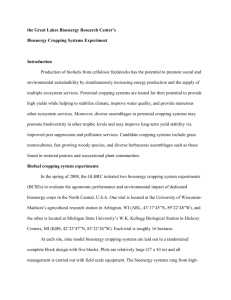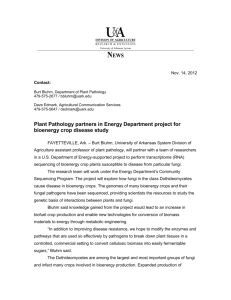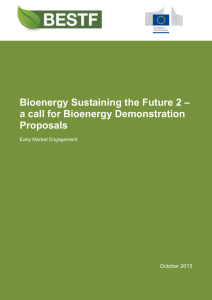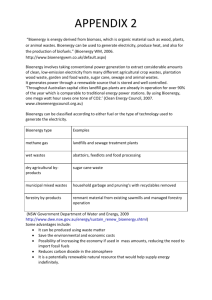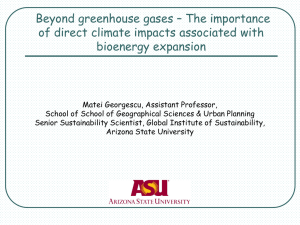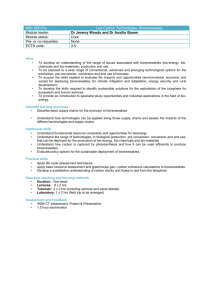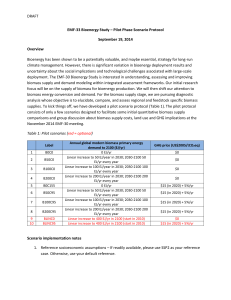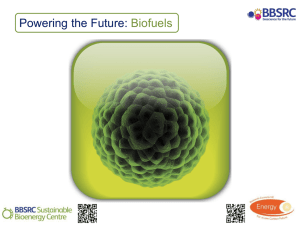Plant material testing (PPTX 12.52MB)
advertisement
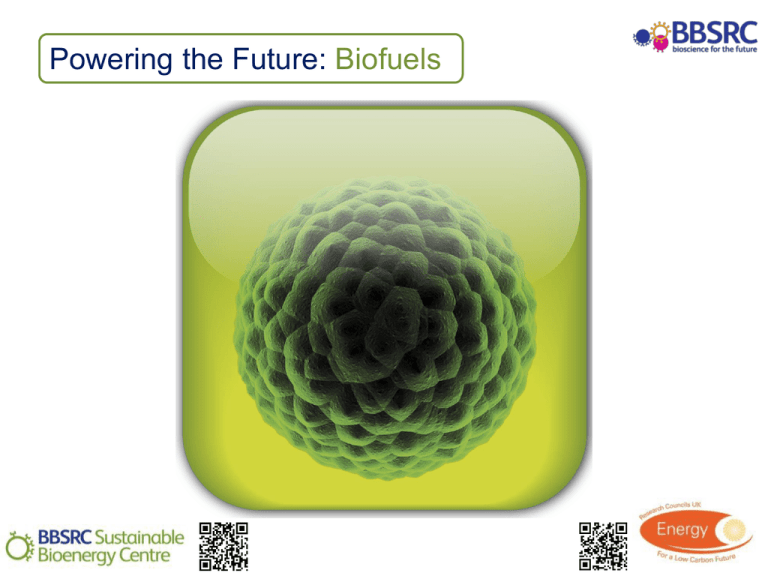
Powering the Future: Biofuels Activity: Plant material testing • Describe the main constituents of plant cells • Carry out staining for lignin and cellulose walls • Compare the constituents of different plant material and suggest the ideal components of biofuel crops Facts and Figures • To help combat climate change the UK has a target to reduce carbon emissions by 80% by 2050. • 30% of the UK renewable energy could come from biomass heat and electricity by 2020. • To meet the European Renewable Energy Directive, the UK is aiming for 10% of transport energy to be from renewable sources by 2020. • By 2020, 8% of our petrol and 5% of our diesel could come from crops grown in the UK. Improving barley straw for bioenergy production and transferring the new knowledge to other crops: Our challenge is to discover how the properties of lignin in barley straw can be changed, to make it easier to produce biofuel (or bioenergy) from this waste material without having any detrimental effects on the yield or quality of the crop. Rothamsted Research Ltd Optimising the yield of fast growing energy crops that are not part of the food chain is one way scientists at Rothamsted Research aim to make sustainable, green bioenergy replacements for fossil fuels a reality. Rothamsted Research Ltd Miscanthus growing at Rothamsted Research: Miscanthus is a fast growing grass which produces biomass very quickly, without competing with the food chain. Research will look at maximising the yield of Miscanthus for sustainable bioenergy production. University of Cambridge Scanning Electron Microscope cross-section of straw: Non-edible waste from agriculture, such as straw, could be used in the future as a secure, green source of fuel without taking up land needed for growing food. Scientists will be looking at this as one possible way to provide sustainable, environmentally friendly bioenergy replacements for fossil fuels. University of Cambridge Stained cross-sections of plant stems: The sugars locked away in the stems of plants would make excellent fuel for sustainable bioenergy. Research will investigate how they could be unlocked for conversion into green bioenergy. Stained cross-sections of plant stems: The University of Dundee at SCRI Plant Cell Walls: Lignin is a strengthening and waterproofing material that encrusts the sugar based polymers in plant cell walls making them hard to access for biofuel production. The John Innes Centre Improving barley straw for bioenergy production and transferring the new knowledge to other crops: Our challenge is to discover how the properties of lignin in barley straw can be changed, to make it easier to produce biofuel from this waste material without having any detrimental effects on the yield or quality of the crop. Light Harvesting complex 2: Photosynthesis is only 6% efficient and it may be possible to improve this to produce higher yielding plants or develop novel ways of capturing solar energy. Rothamsted Research Ltd Willow is a promising energy crop that does not compete with the food chain. Research will look at maximising the biomass yield of willow for sustainable bioenergy production. Harvested Willow at Rothamsted Research: Scientists will investigate how we can maximise the yield of non-food energy crops such as willow so that sustainable bioenergy replacements for fossil fuels become a reality. Rothamsted Research Ltd Switchgrass: Switchgrass is a fast growing grass which produces biomass very quickly, without competing with the food chain. Research will look at maximising the yield of non-food crops for sustainable bioenergy production. © Institute of Food Research Steam explosion unit: We need to optimise the release of sugars from agricultural and wood-industry wastes to produce a fermentable feedstock that microorganisms can use to produce fuels. Pretreatment of feedstocks with steam opens up the structures in plant cell walls to enable access by cellulase enzymes. Plant material testing: Method 1. Carefully using a pair of tweezers and a scalpel, slice a thin transverse section off the stem of the plant. Many sections may be too thick but with practice some sections will be thin enough to use. 2. Place the stem sections in a petri dish of water to keep moist. 3. Repeat steps 2 and 3 to produce a number of sections from each plant stem being investigated. 4. Remove stem section from the petri dish and place on a slide. 5. Remove excess water by carefully touching the edge of the section with absorbent paper. 6. Add 1 to 2 drops of stain to the section. Phloroglucinol should be left for 4 minutes before removing excess stain and adding a drop of HCl 7. Remove excess stain with absorbent paper as before. 8. Slowly lower the coverslip onto the section using the mounted needle making sure that air bubbles are removed from the slide. 9. Label the slide and examine under the microscope. 10. Place any broken or used coverslips and slides in the beaker or sharpsafe. Activity: Plant material testing • Describe the main constituents of plant cells • Carry out staining for lignin and cellulose walls • Compare the constituents of different plant material and suggest the ideal components of biofuel crops Contributors
